The Lok Sabha
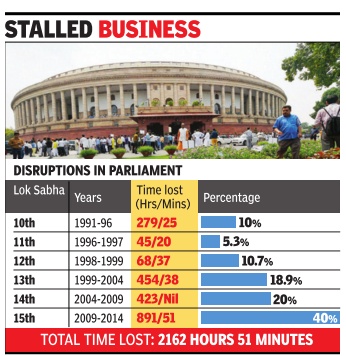
These are newspaper articles selected for the excellence of their content.
|
Contents |
Sessions of Lok Sabha
…and the month of their commencement
First 13 May 1952
Second April 1957
Third April 1962
Fourth March 1967
Fifth March 1971
Sixth March 1977
Seventh January 1980
Eighth December 1984
Ninth December 1989
Tenth June 1991
Eleventh May 1996
Twelfth March 1998
Thirteenth October 1999
Fourteenth May 2004
Fifteenth May 2009
Sixteenth May 2014
Age of MPs, average
1952- 2014
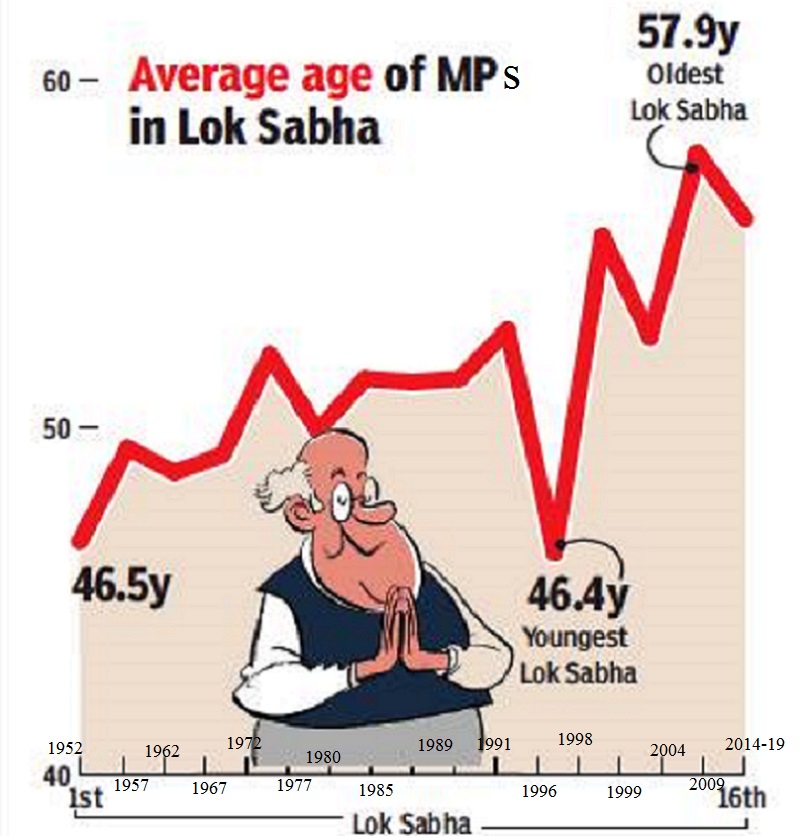
Adapted from The Times of India
See graphic, 'The average Age of Indian MPs, presumably on the date of their swearing-in, 1952- 2014'
Changes over the years
1952- 2014/ 19: Changes in the Lok Sabha
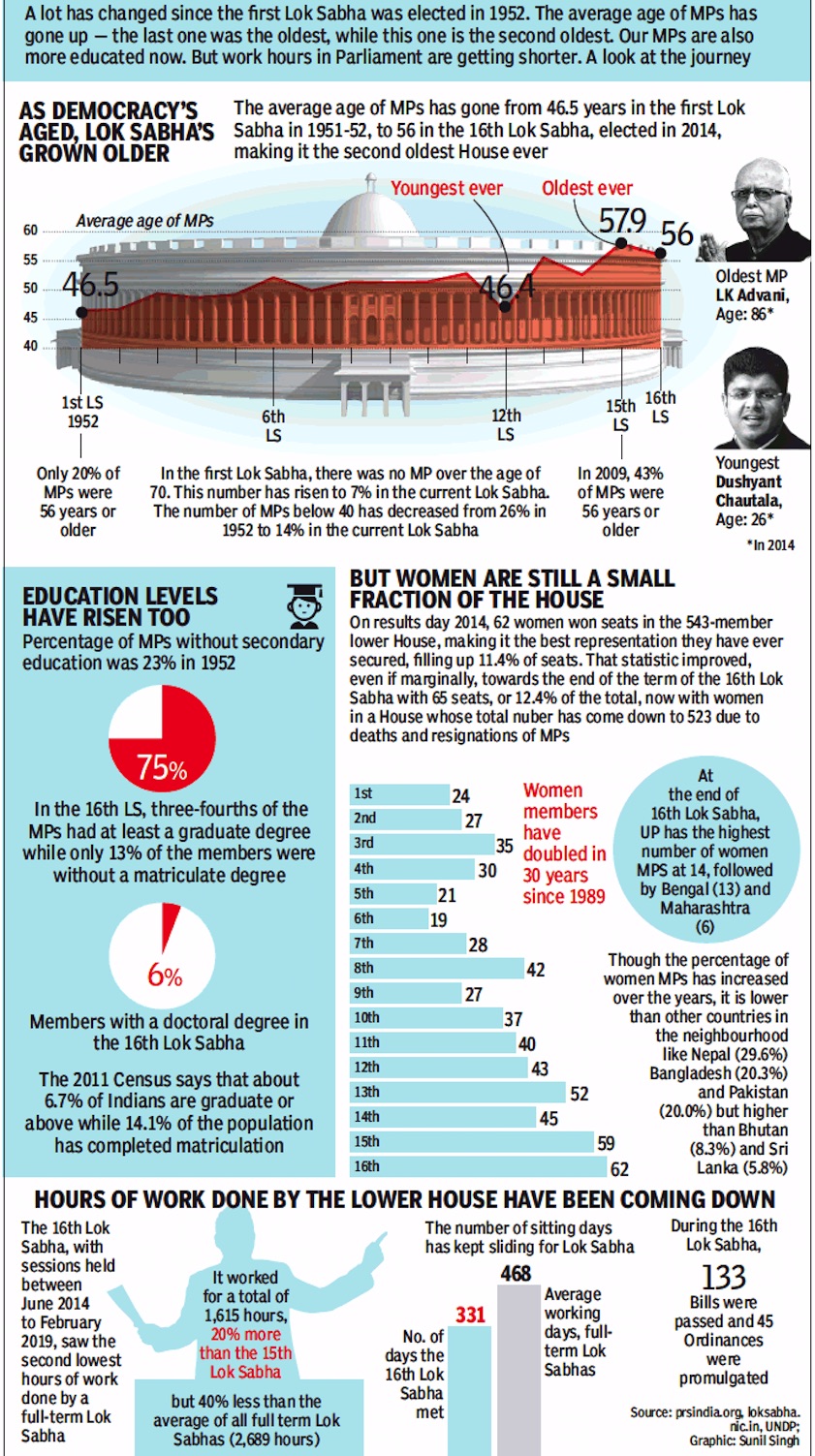
Average age
Education levels
Gender distribution
Hours of work done
From: March 17, 2019: The Times of India
See graphic:
1952- 2014/ 19: Changes in the Lok Sabha’s
Average age
Education levels
Gender distribution
Hours of work done
2012: People per MP ratio
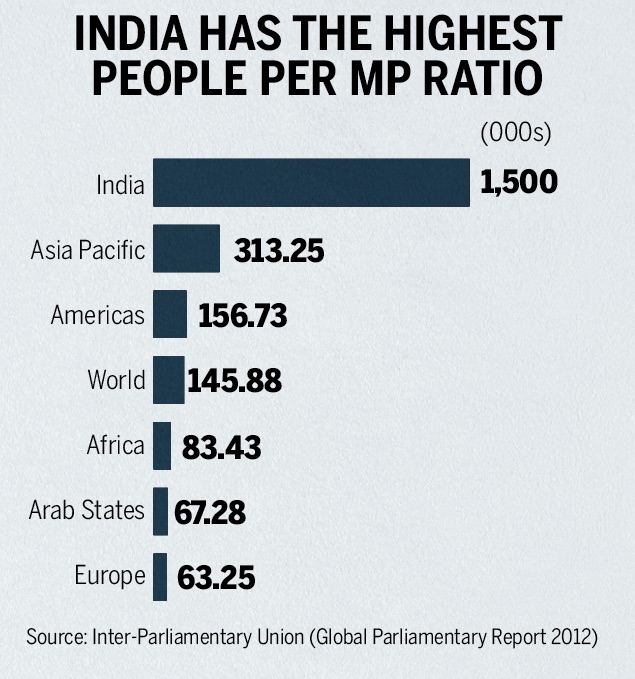
From: March 19, 2019: The Times of India
See graphic:
People per MP ratio, India and some other regions of the world, as in 2012
2014: Biggest/ smallest constituencies

From: March 19, 2019: The Times of India

From: March 19, 2019: The Times of India
See graphics:
Biggest constituencies in 2014
Smallest constituencies in 2014
2019- 2071 (estimate): representation, state-wise
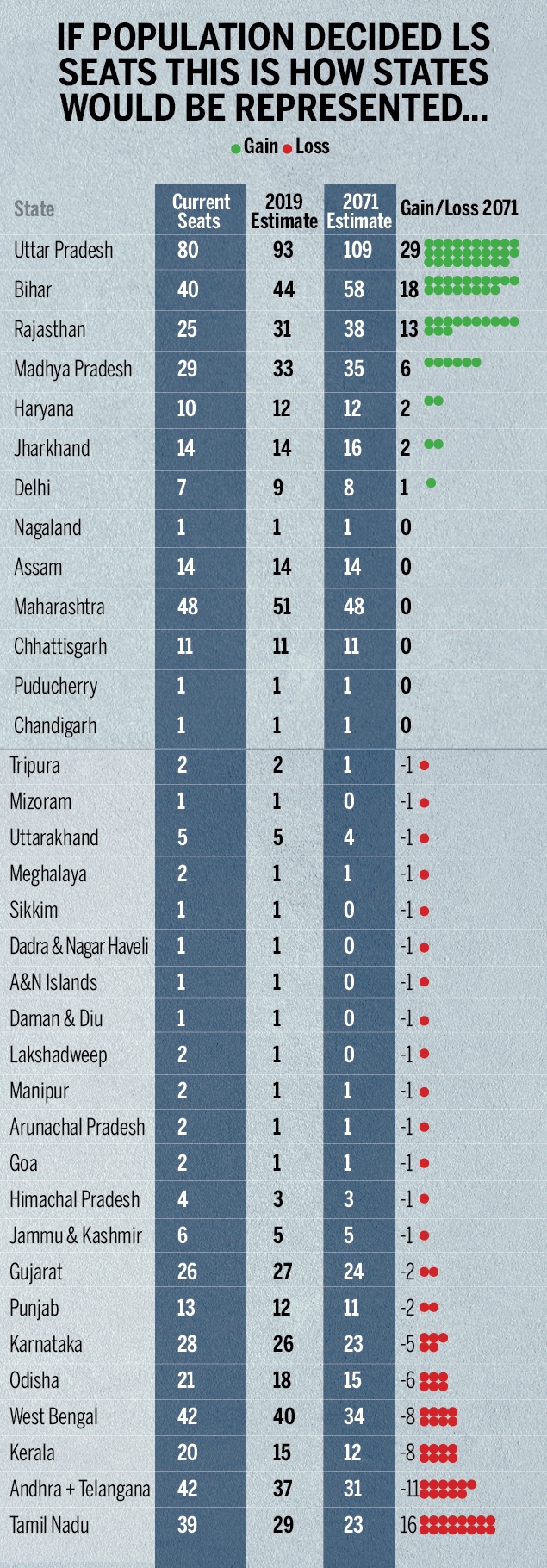
Current seats as in March 20, 2019;
2019 estimate;
2071 estimate;
Gain/Loss 2071;
state-wise
From: March 19, 2019: The Times of India
See graphic:
If population decided seats, this is how states would be represented:
Current seats as in March 20, 2019;
2019 estimate;
2071 estimate;
Gain/Loss 2071;
state-wise
The leader of the opposition
Requirements for being the Leader of Opposition
Cong can't get LoP post in LS: AG to Speaker
Dhananjay.Mahapatra @timesgroup.com New Delhi:
The Times of India Jul 26 2014
In 2014, with just 44 seats, Congres had based its claim for the post of leader of opposition post in the Lok Sabha on the law relating to Salary and Allowances of Leader of Opposition in Parliament Act, 1977 and the rules there under. The law provides the largest opposition party would get the post. Answering a query on this issue posed to him by the 2014 Speaker Sumitra Mahajan, attorney general Mukul Rohatgi referred to the rulings given by highly regarded parliamentarian G V Mavalankar, the first Speaker of the Lok Sabha. He said Mavalankar's directions were adopted to deny LoP status to any party during the period when Jawaharlal Nehru was the PM from 1947 to 1964.
According to Rohatgi, Mavalankar had ruled that to get the post in the Lok Sabha, an opposition party has to secure a minimum of 10% of the seats, that is it must have a strength of 55 MPs.
Rohatgi said Mavalankar had felt that the main opposition party's numbers must equal the quorum, which is 10% of the total strength, required for functioning of the House. Following Mavalankar's ruling, the Congres regimes under Nehru, Indira Gandhi and Rajiv Gandhi had decided not to give the LoP post to the then largest opposition party because they had failed to reach the 55 MP-mark in the Lok Sabha.
The Centre has highlighted direction 121 of `Directions to the Speaker' which provide that a party's strength must be one-tenth of the Lok Sabha to be recognized as a parliamentary party or group.
No-confidence motions
1966-2018

From: July 21, 2018: The Times of India
See graphic :
No-confidence motions moved against the government in the parliament, 1966-2018
Number of seats in the Lok Sabha
Number frozen in 1976
How 1976 seat freeze has altered LS representation, March 16, 2019: The Times of India

From: How 1976 seat freeze has altered LS representation, March 16, 2019: The Times of India
Move Was To Encourage Family Planning And Ensure States That Curbed Population Growth Didn’t Lose Out In Parliament
Article 81 of India’s Constitution laid down that every state (and Union territory) will be allotted seats in the Lok Sabha in such a manner that the ratio of population to seats should be as equal as possible across states. If the letter and spirit of the original provision were to be implemented today, the composition of the Lok Sabha would change drastically with states like Uttar Pradesh, Bihar, Madhya Pradesh, Maharashtra and Delhi gaining significantly and Tamil Nadu, Kerala, Andhra Pradesh, Odisha and Telangana losing out (see graphic).
The reason this hasn’t happened is because in 1976, during the Emergency, the 42nd amendment Act decreed that the population to be taken into consideration for the next 25 years would be the number in the 1971 census. The rationale was that family planning was a national imperative and states would have little incentive to pursue it if success meant their share of political power would go down. The freeze on reapportioning seats between states and UTs was further extended by the 84th amendment Act in 2001 till 2026.
The result of this freeze is that the principle of “one man (or woman) one vote” has been diluted in India? At the time of the apportioning of seats based on the 1971 census, all big states had a Lok Sabha MP representing roughly 10 lakh people. The extent of the variation was from just over 10 lakh to about 10.6 lakh, hardly a huge disparity.
With the seats having remained unchanged but population growth having varied widely, today (based on 2016 mid-year population) the average MP in Rajasthan represents over 30 lakh people while the one in Tamil Nadu or Kerala represents less than 18 lakh. But that has always been the case and is inevitable since even the tiniest UT cannot have less than one MP.
Prior to the 2008 delimitation, the situation was arguably worse with even voters within the same state not having the same weight. The most extreme extreme example of this was in Delhi, where the Chandni Chowk constituency had an electorate of just 3.4 lakh while Outer Delhi had ten times the number at 33.7 lakh.
Prior to the 2008 delimitation, the situation was arguably worse with even voters within the same state not having the same weight. The most extreme extreme example of this was in Delhi, where the Chandni Chowk constituency had an electorate of just 3.4 lakh while Outer Delhi had ten times the number at 33.7 lakh.
The same is reflected elsewhere. In 2014, the five smallest constituencies together had just under 8 lakh voters while the five largest had 1.2 crore voters, 15 times more than the smallest five.
Globally too, India tops the people per MP ratio with India’s 543 MPs serving 1.5 million people each, far higher than the global average of 145,880 persons represented by an MP. Though the number of voters have risen with population growth, the number of seats in Lok Sabha has not increased since 1977. As a result, an MP today represents more than four times the number of voters than what an MP did in 1951-52, when the first general elections were held.
Percentage of women members in Lok Sabha
1952-2009
Source: PRS Legislative Research
India Today June 1, 2009
Ladies first
1952-4.4%
1957-4.5%
1962-6.7%
1967-5.8%
1971-4.9%
1977-3.8%
1980-5.7%
1985-7.9%
1989-5.2%
1991-7.6%
1996-7.4%
1998-8.1%
1999-9.2%
2004-8.7%
2009-10.7%
Productivity
1952-2019

From: February 14, 2019: The Times of India
See graphic:
The productivity of the 1st to the 16th Lok Sabhas, i.e. 1952-2019
Speakers of the Lok Sabha
The speakers: a table
|
First Lok Sabha |
Ganesh Vasudev Mavalankar |
5 May, 1952 – 27 February, 1956 |
|
First Lok Sabha |
M. Ananthasayanam Ayyangar |
8 March, 1956 – 10 May, 1957 |
|
Second Lok Sabha |
M. Ananthasayanam Ayyangar |
11 May, 1957 – 16 April, 1962 |
|
Third Lok Sabha |
Hukam Singh |
17 April, 1962 – 16 March, 1967 |
|
Fourth Lok Sabha |
Neelam Sanjiva Reddy |
17 March, 1967 – 19 July, 1969 |
|
Fourth Lok Sabha |
Gurdial Singh Dhillon |
8 August, 1969 – 19 March, 1971 |
|
Fifth Lok Sabha |
Gurdial Singh Dhillon |
22 March, 1971 – 1 December, 1975 |
|
Fifth Lok Sabha |
Bali Ram Bhagat |
5 January, 1976 – 25 March, 1977 |
|
Sixth Lok Sabha |
Neelam Sanjiva Reddy |
26 March, 1977 – 13 July, 1977 |
|
Sixth Lok Sabha |
K. S. Hegde |
21 July, 1977 – 21 January, 1980 |
|
Seventh Lok Sabha |
Bal Ram Jakhar |
22 January, 1980 – 15 January, 1985 |
|
Eighth Lok Sabha |
Bal Ram Jakhar |
16 January, 1985 – 18 December, 1989 |
|
Ninth Lok Sabha |
Ravi Ray |
19 December, 1989 – 9 July, 1991 |
|
Tenth Lok Sabha |
Shivraj V. Patil |
10 July, 1991 – 22 May, 1996 |
|
Eleventh Lok Sabha |
P. A. Sangma |
23 May, 1996 – 23 March, 1998 (FN) |
|
Twelfth Lok Sabha |
G. M. C. Balayogi |
24 March, 1998 – 20 October, 1999 (FN) |
|
Thirteenth Lok Sabha |
G. M. C. Balayogi |
22 October, 1999 – 3 March, 2002 |
|
Thirteenth Lok Sabha |
Manohar Joshi |
10 May, 2002 – 4 June, 2004 |
|
Fourteenth Lok Sabha |
Somnath Chatterjee |
4 June, 2004 – 31 May, 2009 |
|
Fifteen Lok Sabha |
Smt. Meira Kumar |
3 June, 2009 – 4 June,2014 |
|
Sixteenth Lok Sabha |
Smt.Sumitra Mahajan |
5 June 2014 - |
1952- 2014 repeated, with explanatory footnotes
Sixteenth Lok Sabha Smt.Sumitra Mahajan 5 June 2014 -
Vote margins
1962- 2014/ Closest and widest win margins

From: March 25, 2019: The Hindu
See graphic:
The table shows the closest and widest win margins in Lok Sabha elections in terms of vote percentage, 1962-2014
See also
The 15th Lok Sabha: 2009-14/ The 16th Lok Sabha (2014-19): MPs complete list of MPs / The 16th Lok Sabha (2014-19): trends

